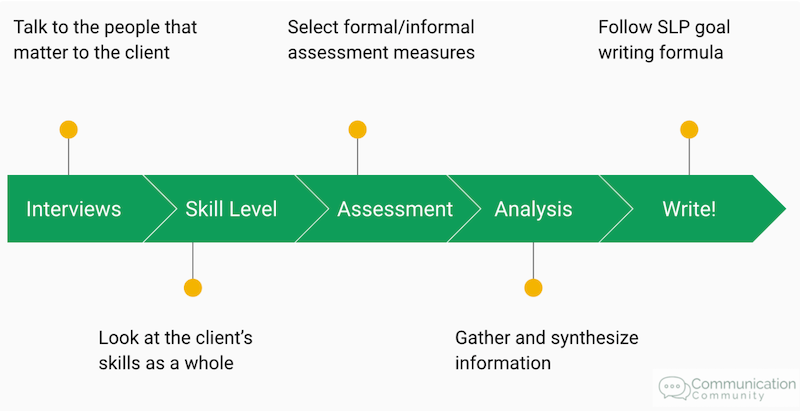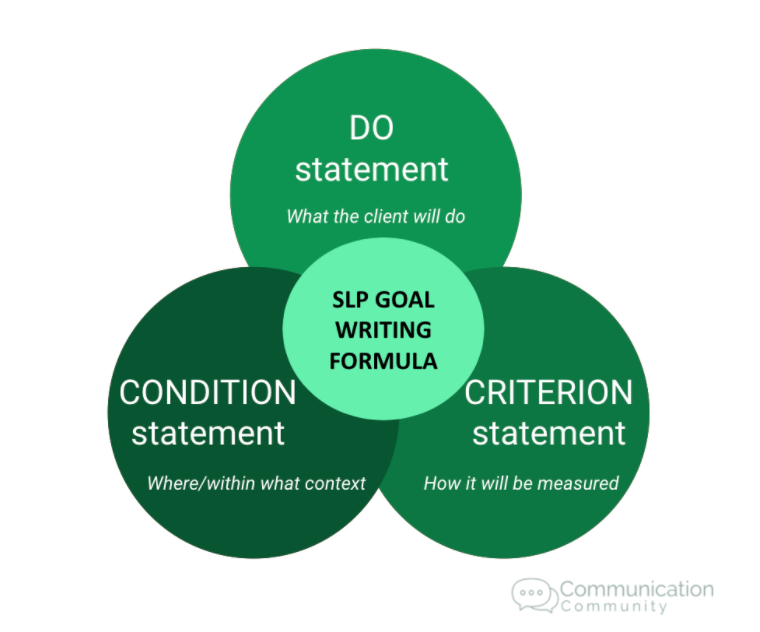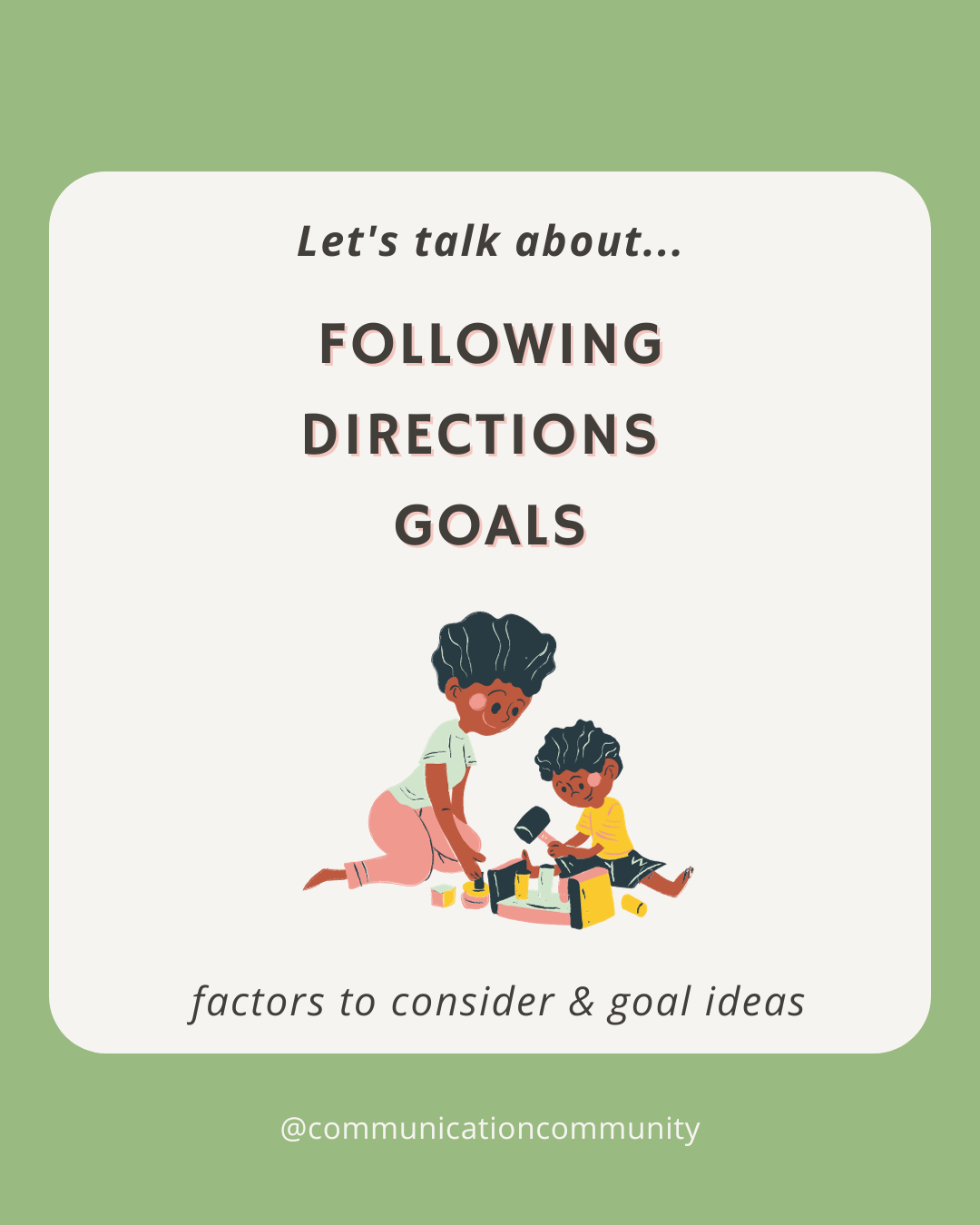Our comprehensive goal banks for school-aged language, AAC, Early Intervention & preschool, and fluency are available on our site or Teachers Pay Teachers store!
Save time creating goals with over THOUSANDS of possible goal combinations. Select your own combination of DO + CONDITION + CRITERION (and consistency) statements to develop personalized and measurable goals for your caseload.

What is Executive Functioning?
Broadly speaking, executive functions include:
- Having the awareness that a specific *thing* needs to be done
- Performing actions that move you towards accomplishing that *thing,* and avoiding actions that move you away from that *thing*
- Assessing your actions that are moving you toward accomplishing that *thing,* despite other distractions.
This *thing* can be any number of tasks, including schoolwork, tests, transitioning to different classes, keeping track of assignments, writing, reading, doing laundry, going grocery shopping, planning a party, and more.
Four Categories of Executive Functioning Skills
- Attention and self-control: attending to relevant information, choosing not to attend to irrelevant information, controlling impulses
- Information processing: taking sensory information from the environment and processing it or reacting to it as necessary. This may also be thought of as working memory.
- Flexible, purposeful behavior: shifting tasks or attention as necessary, learning from mistakes, adapting to changing environments quickly
- Goal setting and achievement: developing goals and ways to accomplish them, anticipating possible outcomes and challenges, self-monitoring oneself and achieving goals
For a more in-depth view of executive functions, including an executive functions development chart, view our complete article on executive functions.
Writing Executive Functioning Goals
- If you haven’t already, check out our article that outlines How to Write Speech Therapy Goals.
- For the purpose of this article, we will focus specifically on writing goals for increasing executive function skills during therapy.
- The first step to writing goals is identifying the area(s) of need. This may include formal and informal assessments, observations, and interviews with clients, parents, teachers, and/or caregivers. Once you have identified the area(s) or need, you can begin composing the goals you are going to write and target.


As seen above, speech goals should be written with 3* components in mind: the DO statement, the CONDITION statement, and the CRITERION statement.
*Also commonly included is consistency (we incorporate this!). Aka: does the individual have to meet a specific criterion more than once? A common example of this may include across 3 consecutive sessions. This is usually something understood by the therapy organization/service provider and is sometimes/sometimes not included in the written goal itself. Including consistency statements ensure that the skill has been generalized and provides more reliable data that the skill has been properly mastered.
DO statement
What the client is actually going to DO and the specific skill they will be working towards.
Example: will attend to language-based tasks
CONDITION statement
The specific setting and/or context your client will work on this skill.
Example: in structured therapy sessions
CRITERION statement
How the client’s performance will be measured.
Example: in 5 minute intervals
DO + CONDITION + CRITERION
Example: [Client] will attend to language-based tasks, in structured therapy sessions, in 5 minute intervals.
There you have it! An example using our Goal Writing Formula containing the DO + CONDITION + CRITERION (don’t forget to think about consistency!) for increasing executive function skills.
Executive Functions Goal Bank
Below are a series of goal examples targeting executive function skills in the four categories mentioned earlier. The goals below can serve as solid examples for common executive function skill areas, in addition to a guide/template to help you generate and customize your own goals. You can take parts of some goals and mix them with others (e.g. take the “do” statement from one goal and the “condition” from another).
Attention and Self-control
[Client] will attend to academic tasks, in the classroom setting, for 3-minute intervals, across 3 out of 5 days.
[Client] will complete homework assignments, in a quiet environment, taking breaks every 10 minutes, in 90% of opportunities.
[Client] will complete a 4-step household chore, using visual supports, with 80% accuracy, in 3 consecutive treatment sessions.
[Client] will initiate a task, in a structured setting, given 1 or fewer prompts, in 80% of opportunities.
Information Processing
[Client] will sequence 3 events, in a story read aloud, with 67% accuracy (e.g. 2/3 events sequenced correctly).
[Client] will verbally describe how to unload a dishwasher in 4 steps, after watching a video simulation, with 75% accuracy.
[Client] will describe what a completed project looks like, given a rubric and verbal explanation, with 80% accuracy, in 2 out of 3 sessions.
Flexible, Purposeful Behavior
[Client] will put lunchbox away upon entering the classroom, during the transition from lunch to class, given 1 or fewer verbal prompts, in 80% of opportunities.
[Client] will shift attention (i.e., gaze, body orientation) back to a task in less than 30 seconds, following an auditory or visual distraction, in 75% of opportunities, in 2 consecutive sessions.
[Client] will identify if they made a mistake, while completing a structured task, in 90% of opportunities.
[Client] will state if/when they need support, in natural settings (e.g., XXX), in 70% of opportunities.
Goal-Setting and Achievement
[Client] will generate a feasible goal to achieve (e.g. a score on a test, cook a meal), in a natural and/or structured environment, in 85% of opportunities.
[Client] will determine the steps needed to achieve the goal (orally or written), during structured therapy sessions, in 85% of opportunities.
[Client] will self-monitor their completion of tasks, given a verbal or visual explanation, with 75% accuracy.
[Client] will determine whether or not they completed a task successfully, in structured settings, with 90% accuracy.
Executive functions can be hard - but improving them can be helpful across many facets of life!
Looking for more goal-related posts (with goal banks)?
Check out the others we have posted:
- How to Write Pragmatic Language Goals
- How to Write Receptive Language Goals
- How to Write AAC Goals
- How to Write Articulation Goals
- How to Write Expressive Language Goals
- How to Write Fluency Goals (Stuttering)
- How to Write Voice Disorders Goals
- How to Write Cluttering Goals
- How to Write Phonological Awareness Goals
- How to Write Aphasia Goals
Want to know how we prep ourselves for goal-writing (and more)?
These are some of our favorite resources for working:
- Clipboard with storage- we use ours ALL THE TIME!
- Some really nice pens - the feel of a pen that writes so well...priceless.
- Blue light glasses- for when excessive screen time is just...necessary
Happy writing!
This post contains some affiliate links and we may be (slightly) compensated if you use them, but all opinions are our own. We appreciate the support!
Citations:
The Source for Development of Executive Functions, Richard/Fahy, 2005
https://leader.pubs.asha.org/doi/10.1044/leader.SCM.24092019.36

![How to Write Executive Functions Goals [with goal bank]](https://www.communicationcommunity.com/content/images/2022/03/EF-Goals.png)
![How to Write Early Intervention Goals for Speech Therapy [goal bank included]](https://www.communicationcommunity.com/content/images/2024/05/How-to-Write-Early-Intervention-Goals---ghost-cover--1--1.png)
![How to Write Stuttering Goals [with goal bank]](https://www.communicationcommunity.com/content/images/2024/03/How-to-Write-Stuttering-Goals---ghost-cover--1-.png)
![How to Write AAC Goals [with goal bank]](https://www.communicationcommunity.com/content/images/2024/03/How-to-Write-AAC-Goals---ghost-cover.png)

![How to Write Apraxia Goals [with goal bank]](https://www.communicationcommunity.com/content/images/2024/01/Apraxia-Goals.png)
